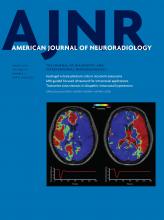Abstract
BACKGROUND AND PURPOSE: Locally compacting the mesh of a flow diverter by a dynamic push-pull technique can accelerate intracranial aneurysm healing. We asked how this deployment strategy compares with overlapping 2 flow diverters for aneurysmal flow reduction.
MATERIALS AND METHODS: Using a high-fidelity virtual stent placement method, we simulated 3 flow-diverter strategies (single noncompacted, 2 overlapped, and single compacted) in 3 aneurysms (fusiform, large saccular, and medium saccular). Computational fluid dynamics analysis provided posttreatment hemodynamic parameters, including time-averaged inflow rate, aneurysm-averaged velocity, wall shear stress, total absolute circulation, and turnover time. We examined the relationship between the achieved degree of compaction and aneurysm orifice area.
RESULTS: Flow-diverter compaction resulted in a compaction coverage of 57%, 47%, and 22% over the orifice of the fusiform, large, and medium saccular aneurysm, respectively. Compaction coverage increased linearly with orifice area. In the fusiform aneurysm, the single compacted flow diverter accomplished more aneurysmal flow reduction than the other 2 strategies, as indicated by all 5 hemodynamic parameters. In the 2 saccular aneurysms, the overlapped flow diverters achieved the most flow reduction, followed by the single compacted and the noncompacted flow diverter.
CONCLUSIONS: Compacting a single flow diverter can outperform overlapping 2 flow diverters in aneurysmal flow reduction, provided that the compaction produces a mesh denser than 2 overlapped flow diverters and this denser mesh covers a sufficient portion of the aneurysm orifice area, for which we suggest a minimum of 50%. This strategy is most effective for aneurysms with large orifices, especially fusiform aneurysms.
ABBREVIATIONS:
- CC
- compaction coverage
- CFD
- computational fluid dynamics
- DPPT
- dynamic push-pull technique
- FD
- flow diverter
- HiFiVS
- high-fidelity virtual stent placement
- IA
- intracranial aneurysm
- © 2017 by American Journal of Neuroradiology
Indicates open access to non-subscribers at www.ajnr.org












